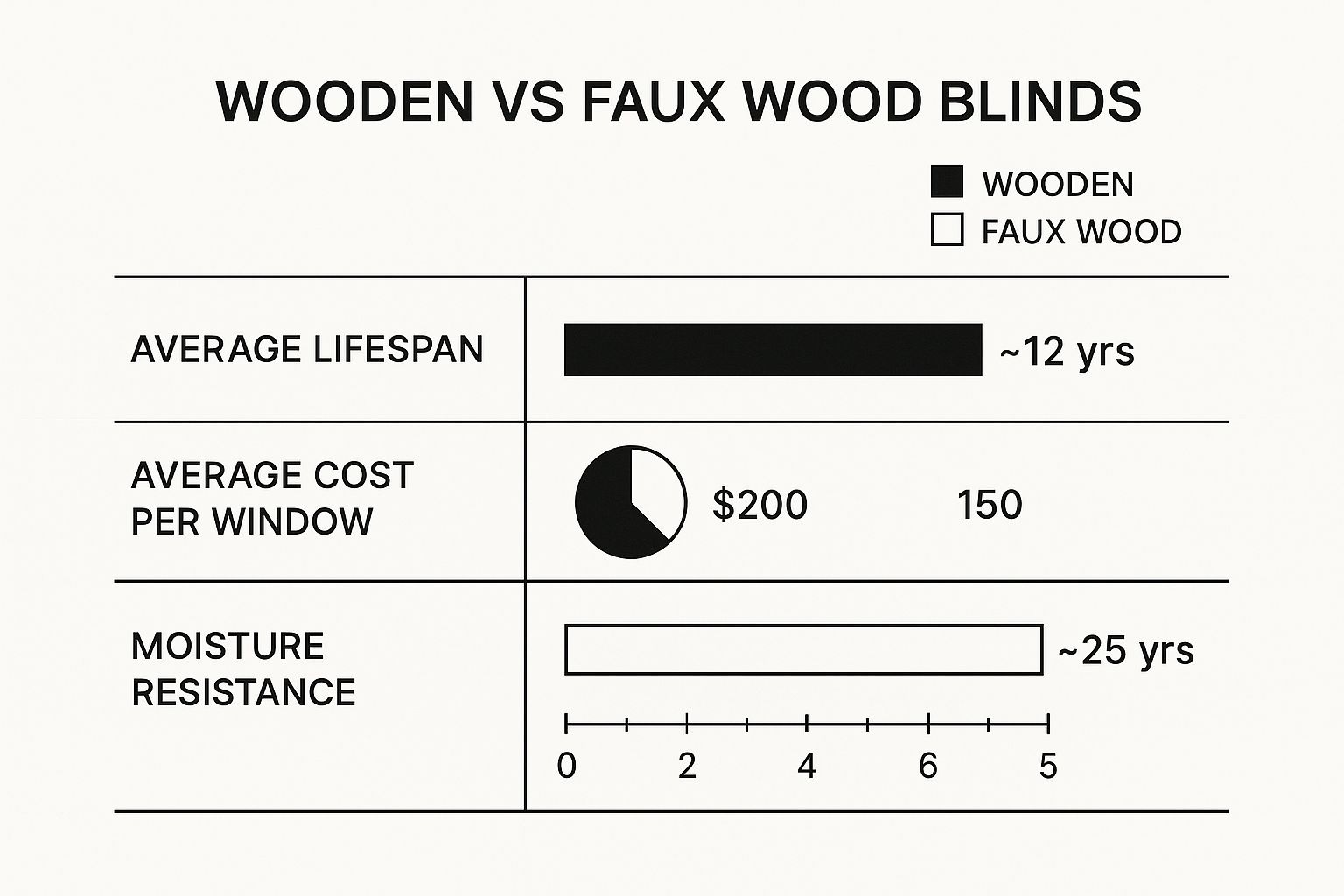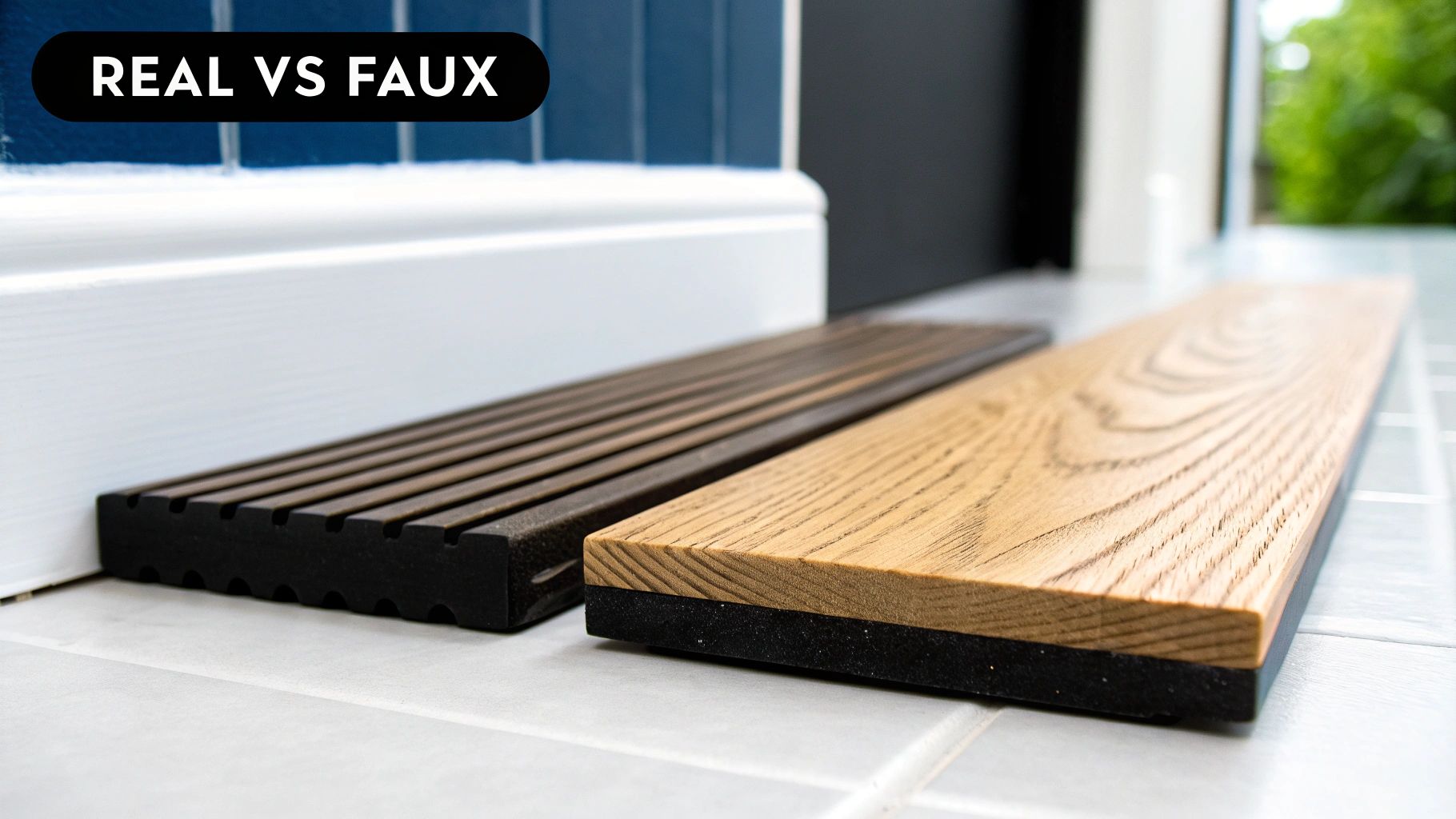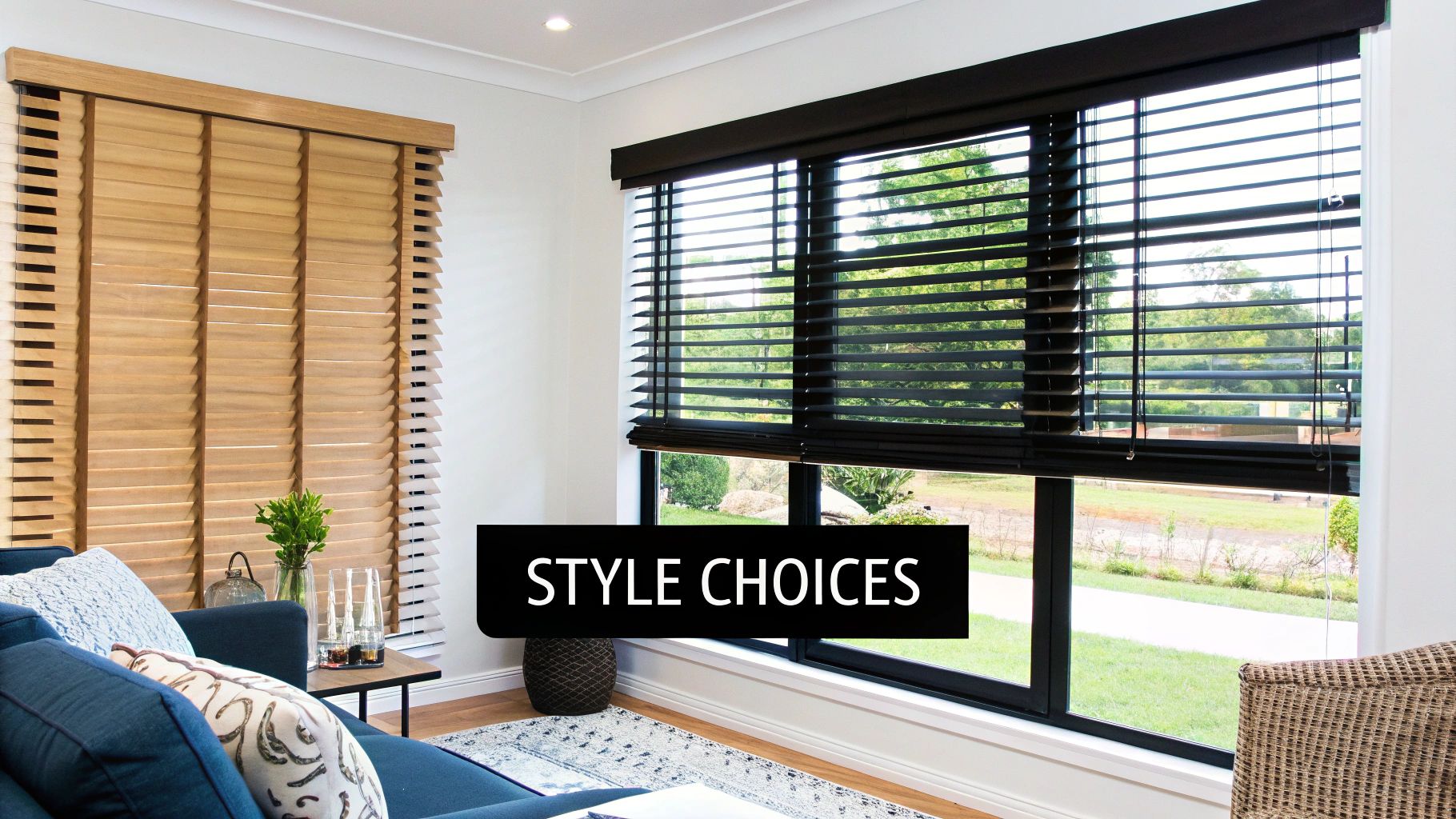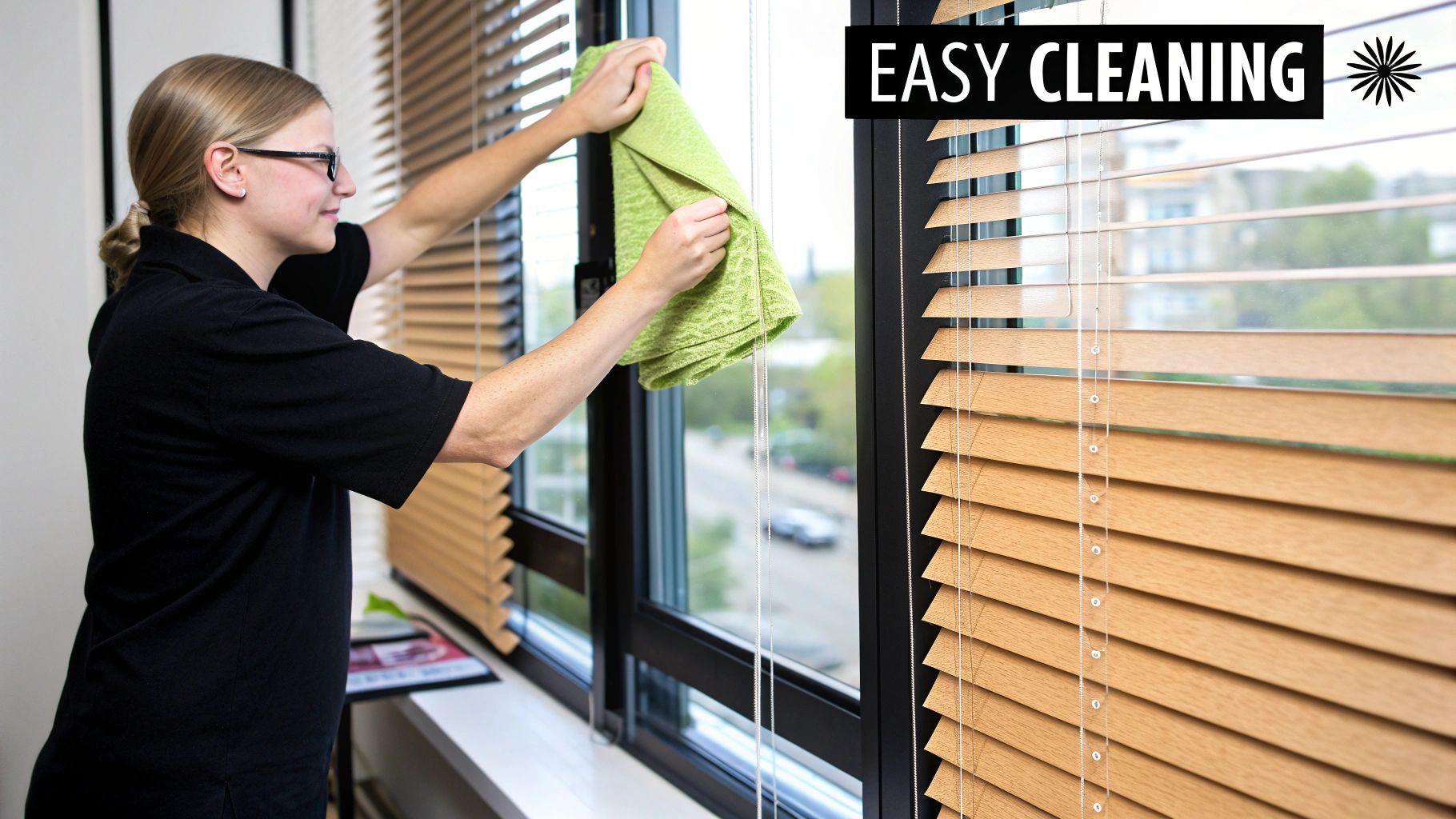Wooden Blinds vs. Faux Wood Blinds: A Guide for Delmarva Homes
- Johann Reardon

- Aug 26
- 11 min read
TL;DR: Real wood blinds offer unmatched natural beauty and are lighter, making them ideal for living rooms and bedrooms in your Delmarva home. Faux wood blinds are moisture-resistant, more durable, and budget-friendly, making them the perfect choice for high-humidity areas like kitchens and bathrooms on the Eastern Shore. The best option depends on the specific room and your lifestyle.
Trying to decide between wooden blinds vs faux wood blinds for your home on the Eastern Shore? At Home Blinds & Floors, we help homeowners across the Delmarva Peninsula find the perfect balance of style, durability, and value with custom window treatments tailored to their space. While both options offer a classic look and excellent light control, their core materials make them suited for very different environments, especially in our coastal climate.
Choosing the Right Blinds for Delmarva's Climate
Choosing the right window treatments is always a balancing act between style, function, and what you want to spend. While both wooden and faux wood blinds give you that classic look and great light control, their fundamental materials really determine where they’ll shine in your Delmarva home.
To get a clearer picture, this quick overview lays out the key differences you’ll want to consider. From free in-home consultations to flawless installation, Home Blinds & Floors takes the stress out of selecting window treatments that are perfect for our local climate.

As you can see, faux wood blinds often pull ahead with a longer lifespan and better moisture resistance, all while costing a bit less upfront. It’s a combination that offers tremendous value for many homeowners in Salisbury, Rehoboth Beach, and beyond.
At a Glance: Wooden Blinds vs Faux Wood Blinds
Sometimes, you just need a straightforward, side-by-side look at the facts. This table cuts through the noise and compares the most important features to help you make an informed choice.
Feature | Real Wood Blinds | Faux Wood Blinds |
|---|---|---|
Material | 100% natural hardwood (basswood, oak) | Composite PVC, vinyl, or wood/PVC blend |
Best For | Living rooms, bedrooms, offices, dry areas | Kitchens, bathrooms, laundry rooms, humid areas |
Moisture Resistance | Prone to warping, cracking, and fading | 100% waterproof and humidity-resistant |
Cost | Higher initial investment | More budget-friendly |
Weight | Lighter, easier for wide windows | Heavier, may require more support |
Aesthetics | Authentic wood grain, rich stains | Smooth, consistent finish; some textured options |
Durability | Can last for years with proper care | Extremely durable, resistant to scratches/dents |
Ultimately, both are fantastic choices, but for very different reasons and in very different spaces.
The Bottom Line: Go with real wood for its unmatched natural warmth and elegance in your main living spaces. But for any room on the Eastern Shore that sees a bit of humidity—from steamy bathrooms to busy kitchens—opt for the bulletproof durability of faux wood.
To dig even deeper, take a look at our complete guide on finding the best blinds for windows near me in Delmarva. This comparison will break down the crucial differences to help you decide which material best suits your home before we explore each aspect in greater detail.
Comparing Material Composition and Craftsmanship

To really get to the heart of the wooden vs. faux wood blind debate, you have to start with what they’re made of. The material itself is the single biggest factor, influencing everything from the final look and feel to where you can realistically install them in your Delmarva home.
Real wood blinds are exactly that—crafted from genuine, natural hardwoods. It’s this craftsmanship that gives them that classic, high-end look so many people are after.
On the other side, you have faux wood blinds, which are engineered for one thing above all else: resilience. Their composite construction is what makes them practically bulletproof against the humidity we see all the time in coastal towns like Salisbury and Easton. As a local, family-run business, Home Blinds & Floors provides personal service, competitive pricing, and professional installation throughout Sussex, Wicomico, Kent, and beyond.
The Authenticity of Natural Hardwood
There’s a reason real wood blinds are so highly valued—it comes down to their authentic, organic beauty. Every single slat has its own story, told through unique grain patterns, knots, and slight color variations.
Premium Materials: Most often, you'll find them made from basswood, a fantastic hardwood that’s both strong and surprisingly light. Basswood’s fine, even texture also takes a stain beautifully, which is how you get those rich, deep wood tones.
Lighter Weight: Natural wood is simply less dense than composite materials, making these blinds much lighter. This is a huge advantage for large windows, as they’re easier to lift and won't put as much strain on the mounting hardware over the years.
Classic Feel: Let's be honest, you just can't perfectly replicate the warmth and timeless elegance that genuine wood brings to a room.
The real magic of wood is in its natural imperfections. No two slats are ever identical, and that's what gives your window a truly custom, high-end feel. It’s a perfect fit for spaces like dining rooms, home offices, and bedrooms.
The Resilience of Engineered Composites
Faux wood blinds are a testament to smart engineering. They were specifically created to overcome the practical weak spots of real wood, especially in tougher environments.
While real wood blinds have been the standard for years, faux wood options have really come into their own because of their sheer durability. True wood blinds are carved from hardwoods like basswood or oak. In contrast, faux wood is typically made from rigid PVC (polyvinyl chloride)—a tough synthetic material that’s completely waterproof and stands up to warping. For a deeper dive into these materials, especially in humid conditions, you can explore this helpful guide to real versus faux wood blinds. If you want to see how different materials stack up for home projects in general, it's worth it to compare different material compositions for home upgrades like windows and doors.
This fundamental difference in material is also why faux wood is often weighed against other durable window treatments. You can learn more by checking out our guide on blinds vs. cellular shades for Delmarva homes. Ultimately, their synthetic build makes them the go-to choice for any room with high moisture.
Performance in Delmarva's Coastal Climate

Life on the Delmarva Peninsula is fantastic, but that beautiful coastal air comes with a serious dose of humidity. That constant moisture in the air has a huge say in which home furnishings last, and your window treatments are right on the front lines. When you're weighing wooden blinds vs faux wood blinds, how they stand up to our unique climate is one of the most important things to consider.
Real wood blinds are stunning, there's no doubt about it. But they have one big weakness in our environment: they don’t like water. The high humidity we see from Rehoboth Beach to Ocean City can make natural wood absorb moisture, which leads to warping, bowing, and even cracking over time. This makes them a real gamble for any room that generates its own steam, like a kitchen or bathroom.
This is exactly where faux wood blinds really shine. Their composite PVC construction is completely non-porous, making them essentially waterproof and immune to what our coastal humidity can throw at them.
Why Faux Wood Is the Smart Choice for High-Moisture Areas
For any room that’s regularly exposed to moisture, faux wood isn’t just an alternative; it's the clear winner. Think about the steam from a hot shower or the humidity that builds up when you're cooking. These are the exact conditions that can ruin real wood blinds.
Faux wood blinds, on the other hand, are built for this. They won’t warp, swell, or develop mildew, which means they’ll look great and work perfectly for years to come. Their inherent resilience makes them the go-to, worry-free choice for the toughest spots in any Delmarva home.
For homeowners here, this is a game-changer. You can get that classic, polished look of wood blinds in your bathroom or over the kitchen sink without ever worrying about them getting damaged. It’s all the style with none of the risk.
From your first in-home consultation to the final installation, our job at Home Blinds & Floors is to make this process easy. We help our clients see how the right material choice impacts not just looks but long-term durability, ensuring you get a product that’s a perfect fit for our local climate.
Maintenance and Upkeep in a Coastal Setting
Beyond just handling humidity, the day-to-day cleaning is another area where faux wood blinds have a big advantage. The mix of salty air and fine dust common to coastal living means surfaces need frequent wiping down.
Faux Wood Blinds: Their smooth, non-porous surface is incredibly simple to clean. Just a quick wipe with a damp cloth gets rid of dust and grime. You never have to worry about water spots or damage.
Real Wood Blinds: Cleaning real wood takes a gentler touch. You have to be careful to avoid harsh cleaners or too much water, which can strip the finish or cause the wood to swell.
That simple cleaning routine gives faux wood a practical edge for any busy household. It's a low-maintenance solution that just makes life easier.
Both types of blinds are also great insulators, which is a nice bonus for keeping energy bills in check throughout the year. For a deeper dive into this, check out our guide to energy-efficient window treatments for Delmarva homes.
Evaluating Aesthetic and Design Versatility
When it comes down to it, how the blinds look is often the deciding factor. The choice between wooden blinds vs faux wood blinds plays a huge role in a room's overall feel, and each material brings something different to the table from a design perspective.
The undeniable appeal of real wood blinds is their authentic, organic charm. Each slat has its own unique grain pattern, giving them a rich, textured look that brings a tangible warmth to a space. This natural elegance makes them a perfect fit for primary living areas like dining rooms, home offices, and bedrooms—anywhere you want to create a sophisticated and inviting atmosphere.
The Natural Warmth of Real Wood
There's just something special about real wood blinds; they really do bring a piece of the outdoors in. The stains used on them are specifically designed to enhance the wood's inherent beauty, not cover it up.
Rich Finishes: You'll find stains ranging from a light, airy oak to a deep, dramatic mahogany, all of which highlight the natural grain and create a sense of depth and luxury.
Lighter Weight Advantage: Natural wood is significantly lighter than composite materials. This means real wood blinds can span much wider windows without needing extra support ladders, which gives you a cleaner, more seamless appearance.
Timeless Character: The subtle variations and unique patterns in each slat mean no two blinds are ever exactly alike. It’s a small detail that gives your windows a truly custom and timeless feel.
The Style Flexibility of Faux Wood
While real wood has a classic look, don't underestimate faux wood. Modern manufacturing has come a long way, producing textures and finishes that are incredibly convincing mimics of genuine wood. They've become a serious contender in the style department.
The biggest aesthetic advantage of faux wood is the sheer breadth of options. While wood is limited to natural stains, faux wood opens the door to a huge palette of colors—from crisp whites and contemporary grays to bold, modern hues.
This versatility is a game-changer. It lets you perfectly match your window treatments to your trim, cabinetry, or overall design scheme. Home Blinds & Floors offers a wide selection of custom blinds and shades in Delmarva, with expert installers who bring the showroom to your living room. There’s no better way to appreciate how closely high-quality faux wood resembles the real thing than seeing and feeling the samples in your own home, with your own lighting.
To get more ideas on how to pick the right style for each room, check out our article on how to choose window treatments with expert tips. It’s packed with insights to help you align your design goals with your practical needs.
Analyzing Cost and Long-Term Value

Let's talk about the bottom line. Any home improvement project comes down to budget, and the choice between wooden and faux wood blinds is a perfect example. But it’s not just about the initial price tag; we need to think about the long-term value, especially with the unique climate we have here on the Delmarva Peninsula.
Right out of the gate, you’ll notice real wood blinds have a higher upfront cost. That’s simply due to the price of natural hardwood and the detailed craftsmanship that goes into making them. Faux wood blinds, on the other hand, are the more budget-friendly option, giving you a remarkably similar look without the premium material expense.
Initial Investment Comparison
When you're looking at quotes, faux wood is almost always going to be the more economical choice. In fact, for a standard-sized window, you can expect faux wood blinds to be about 10-20% less expensive than their genuine wood counterparts. This can really add up, allowing you to outfit more windows for the same amount of money.
While both are built to last, the specific environment of your home plays a huge role. Faux wood's moisture resistance makes it a clear winner for humid areas, while wood’s main draw is its authentic, natural beauty. A deeper dive into the comparison of blind materials and pricing confirms this general cost difference.
Thinking About Long-Term Value
The true value of any window treatment really reveals itself over time. Real wood is undeniably beautiful, but its weakness is moisture. If you install it in the wrong room, you could be looking at costly repairs or replacements down the road.
Think about it this way: choosing durable faux wood blinds for a steamy bathroom in your Bethany Beach home is a brilliant long-term play. That simple decision saves you the future headache—and expense—of dealing with warped or cracked real wood blinds.
As a local, family-run business, Home Blinds & Floors prides ourselves on offering personal service and competitive pricing across Sussex, Wicomico, and Kent counties. Our goal is to find the absolute best value for your specific situation, perfectly balancing that upfront cost with lasting performance. And if you're curious about what goes into a professional setup, our guide on how to measure and install blinds in your Delmarva home offers some great behind-the-scenes insight.
Frequently Asked Questions
When you're trying to decide between real wood and faux wood blinds, a few key questions always seem to pop up. Here are the answers to some of the most common ones we hear from our clients right here on the Delmarva Peninsula.
Are faux wood blinds as stylish as real wood blinds?
They absolutely can be. The technology behind faux wood has come a long way, and modern options have incredibly realistic textures and finishes that mimic genuine wood. While nothing can perfectly replicate the unique grain of a real wood slat, today's high-quality faux wood gets remarkably close, making it a practical and stylish choice for many homeowners in Delmarva.
Which blind type is better for energy efficiency?
This is one area where you can't go wrong. Both real wood and faux wood blinds are fantastic insulators. Their thick slats create a solid barrier that helps block the sun's heat in the summer and retain warmth in the winter. Their performance is very similar, so we recommend focusing on the room's conditions and your preferred style to make your decision.
Do faux wood blinds turn yellow in the sun?
That used to be a common concern, but not anymore. Today's premium faux wood blinds are made with strong UV inhibitors built right in, making them highly resistant to yellowing or fading. The options we offer at Home Blinds & Floors are specifically chosen to stand up to the intense sun we get on the Eastern Shore.
How much do custom blinds cost in Delmarva?
The cost of custom blinds varies based on the material (real wood is typically more expensive than faux wood), the size of your windows, and any special features like motorization. Faux wood blinds offer a great budget-friendly option. We provide a free in-home consultation with a no-obligation quote to give you an exact price for your specific project.
What cities in Delmarva do you serve?
Home Blinds & Floors is proud to cover the entire Delmarva Peninsula. We bring our free in-home consultations and professional installation services to homes and businesses all across Delaware and Maryland's Eastern Shore, including Salisbury, Rehoboth Beach, Lewes, Ocean City, Easton, and all surrounding communities.
Your Go-To Source for Blinds on the Delmarva Peninsula
In summary, Home Blinds & Floors provides custom window treatments, expert advice, and in-home service to homes across the Delmarva Peninsula. Whether real wood blinds are the perfect touch for your living room in Easton or faux wood blinds are the practical solution for your kitchen in Rehoboth Beach, our team is here to help you choose the best shades, shutters, or blinds for your space. Schedule your free consultation today to find the perfect fit for your home.
.avif)
Comments